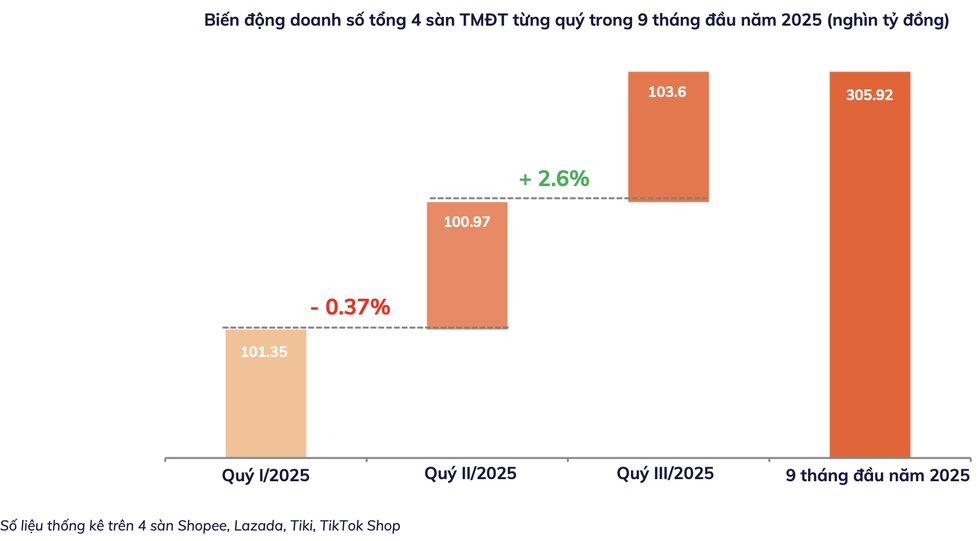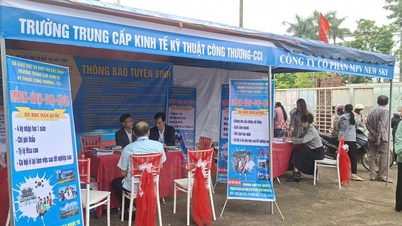$63 billion e-commerce "gold mine"
Vietnam is emerging as one of the most dynamic e-commerce markets in the region. According to the Ministry of Industry and Trade , with a market size exceeding 25 billion USD by 2024, up 20% over the previous year, Vietnam's e-commerce is forecast to achieve a compound annual growth rate (CAGR) of 21.65%, towards a scale of nearly 63 billion USD by 2030.
The government also set ambitious goals, that is, 70% of the adult population will participate in online shopping in the period 2026-2030. The huge potential makes e-commerce a fierce battle between large and small players, thereby creating many new trends, from social commerce, shopping combined with entertainment (shoppertainment) to live broadcasting (livestream commerce).
E-commerce platforms have been applying AI and Big Data to increase personalization of experiences, develop “green commerce”, meet ESG criteria… to be able to reach and retain customers.
Mr. Nguyen Phuong Lam, Director of Market Analysis at YouNet ECI, commented that Vietnam’s e-commerce is no longer a playground for short-term business thinking. Enterprises need to consider this a strategic consumption channel and must seriously invest in brand building and service quality to be able to compete in the long term.
It is forecasted that the Vietnamese e-commerce industry will continue to maintain a compound growth rate of 35% per year until 2028. The two main growth drivers identified are the trend of shopping combined with entertainment (shoppertainment) and the increasingly large value of consumers' shopping baskets.
Meanwhile, in its newly released third-quarter analysis, Metric said TikTok Shop's strong growth momentum continues to reflect the consumer trend of favoring shopping and entertainment platforms (shoppertainment).
This unit's report recommends that e-commerce platforms need to adjust their strategies, increase investment in content and direct interactive sales models. Because users, especially the younger generation like Gen Z, no longer actively search for a specific product, but instead, they discover products in a natural and interesting way through creative content from sellers and influencers.
E-commerce platforms are also expected to increase investment in logistics and improve user experience through incentive programs focusing on essential goods, in order to stabilize purchasing power in the third quarter. This trend reflects the increasing consumer sentiment of product quality assurance, in the context of widespread counterfeit and fake goods.

Revenue from e-commerce platforms grew in the third quarter (Photo: Metric Report).
Platforms promote digital transformation, AI applications... to attract and retain customers
Ms. Tran Nguyen An Ninh, an e-commerce expert, said that currently, many factors such as economic difficulties, users becoming increasingly price-sensitive, fierce competition, etc. are significantly affecting the platforms.
Ms. Ninh especially emphasized that the increase in platform costs is affecting the growth of e-commerce. For example, in just the past 6 months, 80,000 agents left e-commerce platforms, mainly from small retail stores. Not to mention, the return policies and algorithms of the platforms are increasingly strict, causing pressure and difficulty in maintaining access, thereby leading to the phenomenon of "big fish swallowing small fish", small-scale stores are easily eliminated.
According to Ms. Ninh, in the current context, to retain customers, sales must simultaneously apply many methods, from responding to trends through increasing content and interaction via "livestream", to committing to product quality, providing additional after-sales services, accumulating points... so that buyers feel well taken care of.
To do this, e-commerce platforms must increase digital transformation. In particular, applying AI according to experts not only helps reduce the operating costs of the shop (including customer care costs, personnel costs, operations, etc.), but also supports brands in increasing personal shopping experiences for customers.
In addition, Big Data also helps sellers predict customer demand, manage prices more flexibly, etc. AI also supports content creation and better product reviews. “Currently, all platforms are using AI to analyze consumer behavior, recommend SKUs that consumers predict will like the most, and similar items,” the expert commented.
From a technology perspective, Mr. Jason Le - representative of Moloco, a company in the field of Machine Learning applications - said that as a pillar platform in the modern retail sector, technology not only promotes operational efficiency but also helps e-commerce platforms and retail businesses find ways to attract, interact and retain customers in an increasingly competitive environment.
"For today's digital economy, artificial intelligence (AI) and machine learning (ML) are key investments for businesses to build competitive advantage," said Mr. Jason Le.
AI and ML also help retailers identify their most valuable customer groups and provide them with unique experiences to keep them coming back and increase customer lifetime value, experts say.
At the same time, as e-commerce platforms expand, the risk of fraud also increases. With millions of transactions taking place every day, retailers need to leverage AI to detect unusual behavior or data and block suspicious activities in real time.
From quickly identifying counterfeit and prohibited items to preventing account compromise, this proactive approach protects both customers and retailers – a key factor in maintaining long-term consumer trust and driving sustainable growth.
Additionally, by analyzing first-party data, AI and predictive models can optimize ad relevance, frequency, and effectiveness across both on-site e-commerce channels and off-site websites or apps. This not only creates high-margin revenue streams, but also enhances the shopping experience by delivering more contextually relevant ads.

Exchanges promote digital transformation and AI applications to attract and retain customers (Photo: DT).
Regarding the platforms, speaking to Dan Tri reporters, Lazada representatives said that they have improved their market share in recent months, mainly because the platform's customer base is spending more and more. This unit develops AI tools to help personalize the experience for buyers and optimize operations for sellers; promote incentive programs that meet needs as well as expand the catalog of genuine and quality products...
Shopee, not outside the general trend, also diversified its approach to consumers through nearly 380,000 livestream sessions, a series of product review videos, and cooperation campaigns with KOLs/KOCs in its affiliate marketing partner network. This platform stated that nearly 50% of orders sold on October 10 were recorded through Shopee Live and Shopee Video channels.
Draft Law on E-commerce: Strengthening control of livestreaming, tracing counterfeit goods
In his role as an authority, Deputy Director of the Department of Industry and Trade Le Huynh Minh Tu, at a recent event in Ho Chi Minh City, affirmed that in the context of the world entering the digital economic era, digital transformation is no longer an option, but an inevitable requirement for sustainable development. Digital transformation has been, is and will be the key driving force to help businesses improve their competitiveness, optimize their supply chains and bring better experiences to consumers.
Following the direction of Resolution 57 and the National Digital Transformation Program, Ho Chi Minh City aims for the digital economy to account for 40% of GRDP by 2030, in which the trade and service sector, especially retail, plays a leading role.

Deputy Director of the Department of Industry and Trade Le Huynh Minh Tu shared at an event held in Ho Chi Minh City (Photo: DT).
Ms. Nguyen Thi Minh Huyen, Deputy Director of the Department of E-commerce and Digital Economy (Ministry of Industry and Trade) added that the draft Law on E-commerce was completed in September and is expected to be submitted to the National Assembly at the 10th Session in October.
The draft Law on E-commerce focuses on 8 chapters and closely follows 6 policy groups based on the Government's policies and guidelines and practical requirements of state management. First of all, it stipulates the platform models and responsibilities of the subjects participating in e-commerce activities, intermediary platform business activities, social networks and multi-service integrated platforms.
In addition, the Ministry of Industry and Trade will also regulate livestream sales and marketing activities related to the responsibilities of participating entities.
In addition, it will regulate e-commerce activities involving foreign elements and the responsibilities of related entities. At the same time, it will regulate support services for e-commerce and the responsibilities of organizations providing support services. Furthermore, there will be a group of support policies to promote the development of e-commerce in a green and sustainable direction.
In the large content group on e-commerce development, the leader of the Department of E-commerce and Digital Economy said that the Ministry of Industry and Trade proposed stricter control and management measures for counterfeit goods, fake goods, and goods that infringe intellectual property rights.
"Specifically, an important solution proposed is to identify sellers through VNeID with the aim of tracing the seller's goods on e-commerce, thereby effectively controlling counterfeit goods, fake goods, and goods that violate intellectual property rights," she said.
Regarding the issue of dealing with the situation of smuggled, counterfeit and fake goods in e-commerce, Ms. Huyen said that recently, the Ministry of Industry and Trade has issued a plan to monitor, inspect and handle smuggling, trade fraud, counterfeit goods and infringement of intellectual property rights in the new situation.
The Department's leaders said they focus on training to enhance state management capacity in handling violations and managing commercial fraud.
The Department of E-commerce and Digital Economy has coordinated with provinces, cities, and local Departments of Industry and Trade to organize training courses to support market management units with knowledge and skills to inspect and supervise e-commerce activities.
Source: https://dantri.com.vn/kinh-doanh/mo-vang-63-ty-usd-vao-nam-2030-dao-duoc-phai-lam-gi-20251101211227251.htm






![[Photo] Deep sea sand deposits, ancient wooden ship An Bang faces the risk of being buried again](https://vphoto.vietnam.vn/thumb/1200x675/vietnam/resource/IMAGE/2025/11/13/1763033175715_ndo_br_thuyen-1-jpg.webp)






























![[Photo] General Secretary To Lam visits Long Thanh International Airport Project](https://vphoto.vietnam.vn/thumb/1200x675/vietnam/resource/IMAGE/2025/11/13/1763008564398_vna-potal-tong-bi-thu-to-lam-tham-du-an-cang-hang-khong-quoc-te-long-thanh-8404600-1261-jpg.webp)



































![[Photo] Panorama of the 2nd Vietnam-Cambodia Border Defense Friendship Exchange](https://vphoto.vietnam.vn/thumb/402x226/vietnam/resource/IMAGE/2025/11/13/1763033233033_image.jpeg)























![Dong Nai OCOP transition: [Article 3] Linking tourism with OCOP product consumption](https://vphoto.vietnam.vn/thumb/402x226/vietnam/resource/IMAGE/2025/11/10/1762739199309_1324-2740-7_n-162543_981.jpeg)







Comment (0)